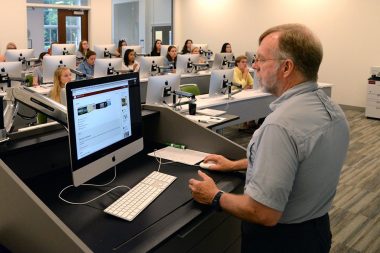To further strengthen Elon's student-centered learning environment, the School of Communications faculty and leadership decided to move to a new format with six undergraduate programs on June 1.
Following the School of Communications’ inception in 2000, the size of its Communications Department grew exponentially, ballooning to more than 1,100 students across five undergraduate majors and two graduate programs. To maintain the close mentorship opportunities students, faculty and staff enjoy and expect, the school has adopted and implemented a new departmental structure.
Beginning on June 1, the school incorporated a new structure with six undergraduate programs, each with its own chair or program director. The programs and their respective leaders are as follows:
- Cinema and Television Arts, Vic Costello
- Communication Design, Randy Piland
- Journalism, Anthony Hatcher
- Media Analytics, Brian Walsh
- Sport Management, Tony Weaver
- Strategic Communications, Bill Anderson

To highlight the new departmental structure and leadership, the school launched a microsite outlining the changes. The site includes a robust FAQ section as well as video interviews with the school’s new leadership.
According to Communications Dean Rochelle Ford, the restructuring was necessary to maintain the strong engaged learning and close mentoring relationships that make an Elon education unrivaled. The curriculum will remain unchanged this fall, as faculty begin a curriculum review to create more enhancements based on industry needs.
For Costello, who is the chair of the Department of Cinema and Television Arts after serving as an associate chair of the Communications Department, the restructuring should be a welcomed change for everyone.
“With more than 1,000 student majors and 60 faculty, the previous Communications Department had reached critical mass, where administratively, it could no longer be effectively managed as a single academic unit with one department chair,” Costello said. “The new administrative structure strengthens our ability to strategically plan for the future while specifically addressing the needs of our faculty and students within their professional discipline or chosen major. The restructuring of the department into smaller academic units will enable more personalized assessment of the curricular and co-curricular programs while encouraging a greater sense of community and identity built around shared professional interests.”
Hatcher, chair of the Journalism Department and a former associate chair of the Communications Department, echoed Costello’s sentiments, noting that the restructuring is the “best way to serve the ever-broadening needs of majors in various fields of communications.”
“I'm looking forward to partnering with my colleagues in strengthening our curriculum, expanding the reach of student media, increasing networking with alumni and other pros, and continuing to stay abreast of industry needs,” Hatcher added. “Journalism faculty at Elon are professionals as well as teachers, and I hope we can fund even more professional development opportunities.”
On the surface, Lellis doesn’t expect that students will notice much of a change when they return in the fall.
“As a School of Communications, we still value, and will strive to maintain, the benefits of a holistic and interdisciplinary program where we embrace the academic and professional intersections that unite us across all majors,” said Lellis, who previously served as an associate chair of the Communications Department.
The new structure’s real benefit to students will be the increased access to department and program leaders, whose expertise aligns more closely with their professional career interests and pursuits. The creation of smaller academic units provides new opportunities for group meetings of faculty and students by major (or interest group) along with more regular communication about events, activities and opportunities specifically tailored to each student’s interests.
Elon’s School of Communications
A private university in North Carolina, Elon University and its School of Communications deliver a student-centered academic experience and access to high-impact experiential learning opportunities, educating students to become data-driven storytellers. Elon is one of 18 private colleges and universities in the nation with an accredited communications school – recognized by ACEJMC and working in alignment with guidelines of the Commission on Sport Management Accreditation (COSMA).


